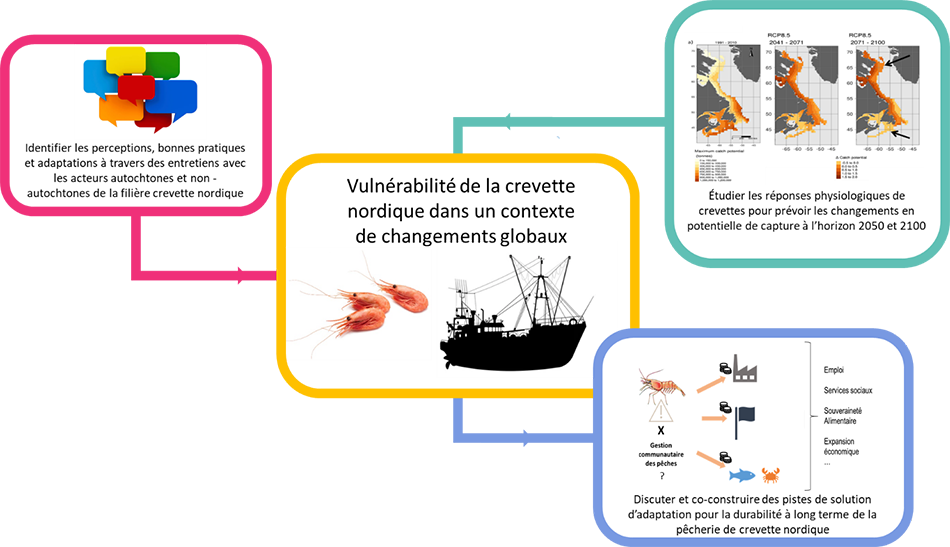Vulnerability of Northern Shrimp Populations to Climate and Global Changes Along the East Coast of Canada - From Natural Resource to Coastal Communities
Raising awareness among key fisheries stakeholders of the expected effects of global ocean changes on northern shrimp populations and fisheries based on new, robust findings.
Project details
Principal(s) investigator(s)

Context
The northern shrimp (Pandalus borealis) is one of the most important exploited species in eastern Canada with 489 million dollars of exports in 2014 (MAPAQ, 2015). It is a driver of economic development for many coastal communities in eastern Canada that are far from major economic centres.
In recent years, northern shrimp populations appear to be declining, particularly in the southern part of their geographic range (Maine, New Brunswick, Nova Scotia). Climate and global changes, including the combined effects of increased temperature, decreasing pH and lower dissolved oxygen concentrations in the marine habitat of northern shrimp, could affect the viability, profitability and sustainability of this fishery .The vulnerability of the northern shrimp and its capacity to respond are currently little known and do not allow us to predict the evolution of this fishery in a context of global change.
Objective(s)
-
To obtain sound information on the vulnerability to climate and global changes of northern shrimp populations along the latitudinal gradient in Quebec and to generate predictions on stock;
-
To assess Quebec’s northern shrimp fishery and identify perceptions, best practices and potential solutions for adapting to global changes;
-
To help identify potential adaptation solutions to best manage the future of shrimp resources and the shrimp industry.
Methodology
-
Measurements of the individual sensitivity of different shrimp stocks to the combined effect of warming, acidification and hypoxia by different integrated physiological measures;
-
Experimental determination of the thresholds of northern shrimp’s sensitivity to the isolated and combined effects of temperature, pH and oxygen;
-
Modelling of the distribution and abundance of northern shrimp in the context of future climate and global change scenarios, looking forward to 2050 and 2100;
-
Identification of the socio-economic effects on coastal communities of the impact of climate and global changes on the shrimp fishery through a series of individual interviews, group discussions and the collection of statistical data;
-
Consultation with the various stakeholders involved in this fishery in order to collaboratively identify long-term management and conservation strategies to respond to the challenges of climate and global changes;
-
Transfer and mobilization of knowledge within the coastal communities of Eastern Canada and the scientific community.
Results
Adult female shrimp are particularly sensitive to the combined conditions of increasing temperature and decreasing pH and dissolved oxygen across the entire matrix of responses measured in different biological compartments. However, shrimp survival is maintained >60% in all scenarios and populations tested, and their organoleptic and nutritional quality is not affected.
The differences in physiological responses between the populations tested are small; there is no evidence of local adaptations. Modelling predicts that northern shrimp will become scarce near the southern limit of their current range, with a decrease in abundance and catch potential and a shift in range toward the north. It also suggests a decrease in the size of this species throughout its range.
This could potentially be due to faster ontogenetic (i.e. two-phase) development in warmer temperature conditions, favouring early sexual maturation at the expense of body growth.

Figure: Summary of the connection between the different components of the project: The northern shrimp fishery in Quebec as an example of the importance of multidisciplinarity, research in partnership and co-construction in discussing solutions for adaptation to the consequences of climate and global change.
Since 1964, the Quebec shrimp fishery has expanded from the Sept-Îles area to the entire St. Lawrence system, particularly in the 1990s. Maximum catch tonnages were observed in 2010, and since then, total allowable catches have been decreasing.
The stakeholders interviewed agree that there has been a decline in the resource since the 2010s. According to them, this situation is due to a multifactorial alteration caused by the return of redfish, climate and global changes, the fishing season and the collection of gestating females.
The decrease of the fishing quotas could jeopardize the profitability of the fisheries. The next generation of fishers could also turn away from the activity in the face of this difficult and uncertain situation.
The Indigenous and non-Indigenous fisheries differ greatly in the way they are organized. However, mutual support and a sense of belonging are very strong among all the participants in this fishery, creating a common desire to manage it sustainably.
Several potential solutions that were co-constructed and are well supported by biological data on the resource and by socio-economic references (opportunities, challenges, barriers) can be envisioned:
-
A change in the dates of the fishing season
-
The diversification of fishing activities
-
The promotion of a local market and of the Quebec terroir
-
The development of an exceptional product with added valued for the local and international market by means of technological innovations
Benefits for adaptation
Benefits for adaptation
Raising awareness among key fisheries stakeholders of the expected effects of global ocean changes on northern shrimp populations and fisheries based on new, robust findings
Mobilizing said stakeholders to identify sustainable solutions to adapt to these impacts while preserving a resource with such high economic, cultural and social value
Developing an interdisciplinary research framework combining natural sciences and socio-economics as well as methods that could be used for other commercially valuable species
Scientific publications
Funding









Other participants
-
Association des Capitaines
-
Propriétaires de Gaspésie
-
Association des Crevettiers Acadiens du Golfe
-
MERINOV
-
Ministère de l’Agriculture, des Pêches et de l’Alimentation du Québec
-
University of British Columbia
-
Institut Maurice Lamontagne (Pêches et Océans Canada)
-
Réseau canadien de recherche sur la pêche
-
Institut des sciences de la mer de Rimouski